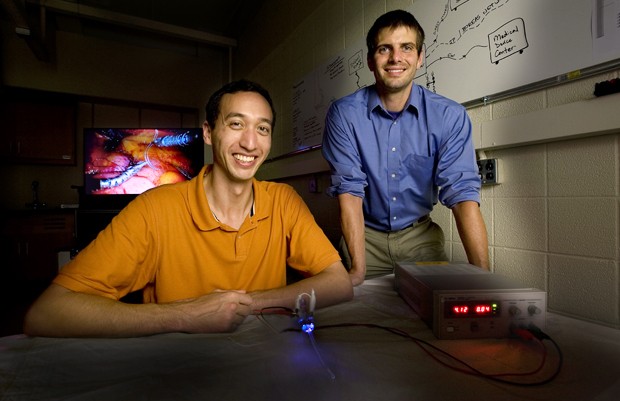Four fellows from the University of MinnesotaâÄôs Medical Devices Center have created an ultraviolet catheter sleeve prototype that will help prevent bloodstream infections. Hospitals in the United States see about 25,000 bloodstream infections caused by central line catheters every year, according to research done by the fellows, who were chosen following a nationwide search. They also learned that catheter infections have become a big financial pain for hospitals since Medicare decided to stop covering the cost. A catheter is a tube that allows fluids to either enter or exit the body. The fellows worked specifically with central line catheters that are inserted into bigger veins. When catheters become infected, they cause large blood stream infections. These infections have resulted in high mortality rates in trauma and cancer patients, said fellow Bryan Rolfes , who is a fourth-year medical student at the Chicago Medical School . Marie Johnson, the fellowsâÄô director at the Medical Devices Center, is in charge of the post-doctoral students that make up the team. The fellowship program started last year when the Medical Devices Center opened on campus. They began the fellowship by reading medical journals and spending a lot of time conducting research. They also closely observed doctors to see where they were struggling. Catheter infections were a problem in every field, Rolfes said. The team then researched the problem and began creating the UV catheter in February 2009. âÄúIt seemed like a good problem to tackle just because there was such a downside from it and there wasnâÄôt a really good solution in place,âÄù said fellow Ben Arcand, a medical device entrepreneur. âÄúAnd it happens fairly often and costs lots of money.âÄù The fellows received assistance from nurses, physicians and others in the health care industry. Several teams from the Carlson School of Management helped the fellows develop their business plans. âÄúThe local community here really embraces the team,âÄù Johnson said. The fellowship program was set up to allow the fellows to create devices but did not give them enough time to commercialize their projects. âÄúThe biggest downside to it is that itâÄôs only a year,âÄù Arcand said. The invention is designed so a catheter can be slid into the polymer sleeve, which extends from outside the skin into the artery or vein being used. The sleeve is clear and âÄúacts as a light pipe to bring UV light down to the surrounding tissue and to the surface of the catheter,âÄù Arcand said. Several light-emitting diodes (LEDs) on the end of the sleeve then transmit the UV light. There is also a small battery and a circuit board that controls the lights. âÄúPeriodically, the UV lights would switch on and send light down the sleeve, kind of bathing the surrounding tissue and catheter in UV light and preventing bacterial colonies from growing,âÄù Arcand said. Though the fellows originally looked into using antibiotics in their project, they ultimately rejected the idea. When bacteria develop on the outside of the catheter, they develop a layer of biofilm. The bacteria are then protected from the antibiotic on the catheterâÄôs surface, Arcand said. UV light, however, can go through biofilm. âÄú[The UV light] would help eliminate any of the pathogens that might be in the skin or any of the pathogens that might track along the catheter into the blood vessels,âÄù said fellow Joe Hale, who is now involved in a startup medical device company. Though UV light technology has been utilized in water purification, it has not been used very much in medical devices, Hale said. New developments with the LEDs that emit UV light have made this feasible. Besides the sleeve, the team also worked on several other projects. Their mercury abatement project was just licensed. âÄúTo be honest, [the fellowship] is probably the most interesting and enjoyable thing that IâÄôve done so far,âÄù Arcand said. A fourth member of the team, Nikhil Murdeshwar , also worked on the project.











